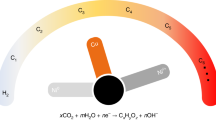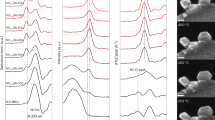Abstract
Exploring highly selective catalysts for CO hydrogenation reactions remains a significant challenge as a critical stage in the conversion of CO resources into chemicals or fuels. Here, we provide guidelines on this issue, exploring the generation of major production in the CO hydrogenation process of M1/W6S8 (M = Ir and Ca) single-atom catalysts, and performing density functional calculations. Calculate the reaction energy and barrier for each basic step. Calculations represent that the Ca1/W6S8 catalyst is very advantageous for methanol synthesis (CO* + 4H* → CHO* + 3H* → CH2O* + 3H* → CH3O* + H* → CH3OH*). On the other hand, the Ir1/W6S8 catalyst strongly favors the production of C2 hydrocarbons. We use the harmonic transition state theory to calculate the rate constant of the subsequent step of converting CH3O* species on M1/W6S8 (M = Ir and Ca). The results of the rate constants are consistent with our kinetic results. These results add new insights into the basic understanding of complex CO hydrogenation reactions.
Graphic Abstract
A series of reactions starting from CO on the (a) Ir1/W6S8, (b) Ca1/W6S8. The activation barriers and reaction energies of the elementary steps are all shown in kcal/mol.









Similar content being viewed by others
References
Field CB, Mach KJ (2017) Rightsizing carbon dioxide removal. Science 356:706–707
Tollefson J (2009) World looks ahead post-Copenhagen. Nature 462:966–967
Wei Z, Sun J, Li Y et al (2012) Bimetallic catalysts for hydrogen generation. Chem Soc Rev 41:7994–8008
Alonso DM, Wettstein SG, Dumesic JA (2012) Bimetallic catalysts for upgrading of biomass to fuels and chemicals. Chem Soc Rev 41:8075–8098
Dry ME (1996) Practical and theoretical aspects of the catalytic Fischer-Tropsch process. Appl Catal A 138:319–344
Dry ME (2002) High quality diesel via the Fischer-Tropsch process-a review. J Chem Technol Biotechnol 77:43–50
Gong XQ, Raval R, Hu P (2004) CO dissociation and O removal on Co(0001): a density functional theory study. Surf Sci 562:247–256
Overett MJ, Hill RO, Moss JR (2000) Organometallic chemistry and surface science mechanistic models for the Fischer-Tropsch synthesis. Coord Chem Rev 206:581–605
Ciobîca IM, Kramer GJ, Ge Q et al (2002) Mechanisms for chain growth in Fischer-Ttropsch synthesis over Ru(0001). J Catal 212:136–144
Liu ZP, Hu P (2002) A new insight into Fischer-Tropsch synthesis. J Am Chem Soc 124:11568–11569
Dry ME (2002) The Fischer-Tropsch process: 1950-2000. Catal Today 71:227–241
O”Byrne JP, Owen RE, Minett DR et al (2013) High CO2 and CO conversion to hydrocarbons using bridged Fe nanoparticles on carbon nanotubes. Catal Sci Technol 3:1202–1207
Du G, Lim S, Yang Y et al (2007) Methanation of carbon dioxide on Ni-incorporated MCM-41 catalysts: the influence of catalyst pretreatment and study of steady-state reaction. J Catal 249:370–379
Dorner RW, Hardy DR, Williams FW et al (2009) Influence of gas feed composition and pressure on the catalytic conversion of CO2 to hydrocarbons using a traditional cobalt-based Fischer-Tropsch catalyst. Energy Fuels 23:4190–4195
Yang C, Zhao H, Hou Y et al (2012) Fe5C2 nanoparticles: a facile bromide-induced synthesis and as an active phase for Fischer-Tropsch synthesis. J Am Chem Soc 134:15814–15821
Elahifard MR, Fazeli E, Joshani A et al (2013) Ab-initio calculations of the CO adsorption and dissociation on substitutional Fe-Cu surface alloys relevant to Fischer-Tropsch synthesis: bcc-(Cu)Fe(100) and fcc-(Fe)Cu(100). Surf Interface Anal 45:1081–1087
Torrente-Murciano L, Chapman RS, Narvaez-Dinamarca A et al (2016) Effect of nanostructured ceria as support for the iron catalysed hydrogenation of CO into hydrocarbons. Phys Chem Chem Phys 18:15496–15500
Weatherbee GD, Bartholomew CH (1984) Hydrogenation of CO2 on group VIII metals: IV. specific activities and selectivities of silicasupported Co, Fe, and Ru. J Catal 87:352–362
Kishan G, Lee MW, Nam SS et al (1998) The catalytic conversion of CO2 to hydrocarbons over Fe-K supported on Al2O3-MgO mixed oxides. Catal Lett 56:215–219
Zhao YH, Hao QQ, Song YH et al (2013) Cobalt supported on alkaline-activated montmorillonite as an efficient catalyst for Fischer-Tropsch synthesis. Energy Fuels 27:6362–6371
Fischer F, Tropsch H (1926) Synthesis of petroleum at atmospheric pressure from gasification products of coal. Brennstoff-Chemie 7:97–104
Henrici-Olive G, Olive ́ S (1976) The Fischer-Tropsch synthesis: nolecular weight distribution of primary products and reaction mechanism. Angew Chem Int Ed Engl 15:136–141
van Santen RA, Markvoort AJ (2013) Chain growth by CO insertion in the Fischer-Tropsch reaction. ChemCatChem 5:3384–3397
Hindermann JP, Hutchings GJ, Kiennemann A (1993) Mechanistic aspects of the formation of hydrocarbons and alcohols from CO hydrogenation. Catal Rev Sci Eng 35:1–127
Khodakov AY, Chu W, Fongarland P (2007) Advances in the development of novel cobalt Fischer-Tropsch catalysts for synthesis of long-chain hydrocarbons and clean fuels. Chem Rev 107:1692–1744
Rofer-DePoorter CKA (1981) Comprehensive mechanism for the Fischer-Tropsch synthesis. Chem Rev 81:447–474
Liu J (2017) Catalysis by supported single metal atoms. ACS Catal 7:34–59
Yang S, Tak YJ, Kim J et al (2017) Support effects in single atom platinum catalysts for electrochemical oxygen reduction. ACS Catal 7:1301–1307
Xuan W, Lili Z, Jiaye J et al (2018) Observation of alkaline earth complexes M(CO)8 (M = Ca, Sr, or Ba) that mimic transition metals. Science 361:912–916
Liu P, Choi Y, Yang Y et al (2010) Methanol synthesis from H2 and CO2 on a Mo6S8 cluster: a density functional study. J Phys Chem A 114:3888–3895
Liu C, Liu P (2015) Mechanistic study of methanol synthesis from CO2 and H2 on a modified model Mo6S8 cluster. ACS Catal 5:1004–1012
Yvon K (1979) Current topics in materials science, vol 3. North-Holland Publishing, Amsterdam
Perruchas S, Flores S, Jousselme B et al (2007) [W6S8] Octahedral tungsten clusters functionalized with thiophene derivatives: toward polymerizable building blocks. Inorg Chem 46:8976–8987
Frisch MJ, Trucks GW, Schlegel HB et al (2009) Gaussian 09, revision A.1. Gaussian Inc., Wallingford, CT
Lee C, Yang W, Parr RG (1988) Development of the Colle-Salvetti correlation-energy formula into a functional of the electron density. Phys Rev B 37:785–789
Mardirossian N, Head-Gordon M (2017) Thirty years of density functional theory in computational chemistry: an overview and extensive assessment of 200 density functionals. Mol Phys 115:2315–2372
Li M, Chen J, Wang G (2016) Reaction mechanism of ethanol on model cobalt catalysts: DFT calculations. J Phys Chem C 120:14198–14208
Xing SK, Wang GC (2013) Reaction mechanism of ethanol decomposition on Mo2C(100) investigated by the first principles study. J Mol Catal A 377:180–189
Hay PJ, Wadt WR (1985) Ab initio effective core potentials for molecular calculations. Potentials for K to Au including the outermost core orbitals. J Chem Phys 82:299–311
Perdew JP, Burke K, Ernzerhof M (1996) Generalized gradient approximation made simple. Phys Rev Lett 77:3865–3868
Gonzalez C, Schlegel HB (1990) Reaction path following in mass-weighted internal coordinates. J Phys Chem 94:5523–5527
Huber KP, Herzberg G (1979) Molecular spectra and molecular structure: IV constants of diatomic molecules. Van Nostrand Reinhold, New York
Wynne-Jones WFK, Eyring H (1935) The absolute rate of reactions in condensed phases. J Chem Phys 3:492–502
McQuarrie DA (2000) Statistical mechanics, 2nd edn. University Science Books, Sausalito, CA
Jin S, Disalvo FJ (2002) 3-D coordination network structures constructed from [W6S8(CN)6]6− anions. Chem Mater 40:3448–3457
Ehrlich GM, Warren CJ, Vennosn DA et al (1995) Synthesis, structure, and characterization of N-Ligated W6S8L6 cluster complexes. Inorg Chem 34:4454–4459
Shetty S, Jansen APJ, Santen RAV (2009) Direct versus hydrogen-assisted CO dissociation. J Am Chem Soc 131:12874–12875
Ojeda M, Nabar R, Nilekar AU et al (2010) CO activation pathways and the mechanism of Fischer − Tropsch synthesis. J Catal 272:287–297
Yang J, Qi YY, Zhu J et al (2013) Reaction mechanism of CO activation and methane formation on Co Fischer − Tropsch catalyst: a combined DFT, transient, and steady-state kinetic modeling. J Catal 308:37–49
Liu J, Su HY, Sun DP et al (2013) Crystallographic dependence of CO dctivation on cobalt catalysts: HCP versus FCC. J Am Chem Soc 135:16284–16287
Lu XQ, Deng ZG, Wei SX et al (2015) CO tolerance of a Pt3Sn(111) catalyst in ethanol decomposition. Catal Sci Technol 5:3246–3258
Li HJ, Chang CC, Ho JJ (2011) Density functional calculations to study the mechanism of the Fischer-Tropsch reaction on Fe(111) and W(111) surfaces. J Phys Chem C 115:11045–11055
Zhao YH, Sun K, Ma X et al (2011) Carbon chain growth by formyl insertion on rhodium and cobalt catalysts in syngas conversion. Angew Chem Int Ed 50:5335–5338
Acknowledgements
This work was financially supported by the “1331” project of Shanxi Province, High School 131 Leading Talent Project of Shanxi, the Natural Science Foundation of Shanxi, and Undergraduate Training Programs for Innovation and Entrepreneurship of Shanxi Province, Graduate student innovation project of Shanxi Normal University (01053017). Shanxi Graduate Education Innovation Project (2019SY298).
Author information
Authors and Affiliations
Corresponding author
Additional information
Publisher's Note
Springer Nature remains neutral with regard to jurisdictional claims in published maps and institutional affiliations.
Electronic Supplementary Material
Below is the link to the electronic supplementary material.
Rights and permissions
About this article
Cite this article
Hao, Z., Han, Y., Guo, S. et al. A Comparative Study on C2 Hydrocarbons and Methanol Synthesis from CO Hydrogenation Catalyzed by M1/W6S8 (M = Ir and Ca) Single-Atom Catalysts. Catal Lett 150, 1515–1526 (2020). https://doi.org/10.1007/s10562-019-03007-y
Received:
Accepted:
Published:
Issue Date:
DOI: https://doi.org/10.1007/s10562-019-03007-y




